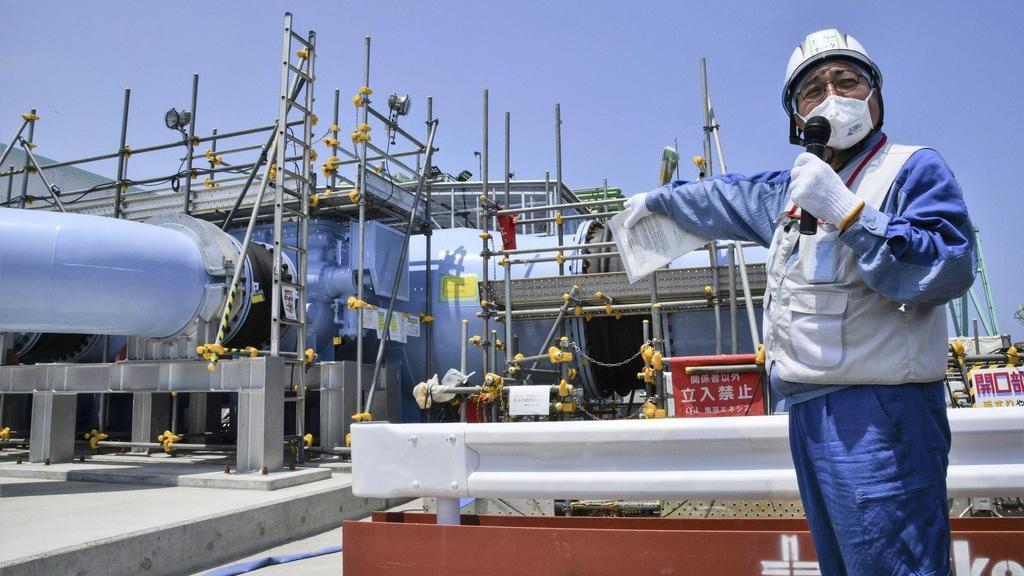 An employee of Tokyo Electric Power Company explains about the facility to be used to release treated radioactive water to media at Fukushima Daiichi nuclear power plant in Fukushima, northern Japan, on June 26, 2023. (PHOTO / AP)
An employee of Tokyo Electric Power Company explains about the facility to be used to release treated radioactive water to media at Fukushima Daiichi nuclear power plant in Fukushima, northern Japan, on June 26, 2023. (PHOTO / AP)
BEIJING - It is against common science to put the nuclear-contaminated water from Japan's Fukushima nuclear plant and the water released from normally functioning nuclear power plants in the same category. If some people think that the nuclear-contaminated water is safe to drink or swim in, Japan should save it for those people instead of releasing it into the sea, Chinese foreign ministry spokesperson Wang Wenbin said on Tuesday.
The IAEA didn't assess the efficacy and long-term reliability of Japan's treatment facilities and therefore cannot guarantee that all nuclear-contaminated water will be up to standard after treatment in the next 30 years. The impact of long-running discharge on the marine environment and food safety is not something that the IAEA can easily draw a conclusion on, said Chinese foreign ministry spokesperson Wang Wenbin
Wang's remarks came after the International Atomic Energy Agency (IAEA) chief reportedly said on several occasions that one could drink or swim in the "treated water" from Fukushima and that the "treated water" is as harmless as the water discharged from nuclear power plants in other countries.
ALSO READ: China once again urges Japan to stop nuke water discharge plan
Wang said that just a brief look at recent media coverage can one find that the IAEA safety review has indeed been controversial. Experts who participated in the review have expressed views different from the final report. That is an indisputable fact.
This shows once again that the IAEA released the review on this complex issue too hastily, and the conclusion has its limitations and is narrowly focused without addressing the world's concerns over the discharge plan. Japan cannot just use the IAEA report as a "greenlight" for the ocean discharge, Wang said.
"I need to point out once again that it is against common science to put the nuclear-contaminated water from Japan's Fukushima nuclear plant and the water released from normally functioning nuclear power plants in the same category, given the uncertainty about whether the former will meet safety standards after treatment," said Wang, adding that these two types of water are inherently different as they come from different sources, contain different radionuclides and require different levels of sophistication in terms of the treatment methods involved.
ALSO READ: Various sectors in HK oppose Japan nuke water discharge plan
He said that the nuclear-contaminated water in Fukushima comes from the cooling water injected into the damaged reactor cores, as well as seepage of groundwater and rainwater after the Fukushima nuclear disaster, and it contains various radionuclides released from the damaged reactor cores, which is totally different from the normal water discharge from operating nuclear power plants.
The IAEA didn't assess the efficacy and long-term reliability of Japan's treatment facilities and therefore cannot guarantee that all nuclear-contaminated water will be up to standard after treatment in the next 30 years. The impact of long-running discharge on the marine environment and food safety is not something that the IAEA can easily draw a conclusion on, Wang said.
ALSO READ: Fukushima fishermen remain opposed to wastewater discharge
"If some people think that the nuclear-contaminated water from Fukushima is safe to drink or swim in, we suggest that Japan save the nuclear-contaminated water for these people to drink or swim in, instead of releasing it into the sea and causing widespread concerns internationally," said the spokesperson.


